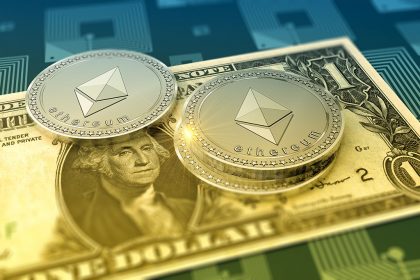Tron (TRX) price forecast for 2025–2030 with insights on token utility, growth drivers, market trends, and long-term investment ou...
How to Sell Ethereum (ETH)?
Last Updatedby Andy Watson · 7 mins read

There might come a time when you collected enough Ethereum that you want to turn back into fiat currency or purchase another crypto token instead. This step-by-step guide will lead you through the whole process of selling ETH.
After either mining or purchasing Ethereum (ETH), there may come a realization that Ethereum is still not able to pay for the utility bills. In that instance, crypto exchanges can be a viable option to give you the desired amount of other currency.
Things to Be Aware of Before Selling ETH

Photo: Pixabay
Types of Platform
There are two predominant types of exchanges: centralized and decentralized. The difference between the two lies in the degree of control the user maintains over funds. As from the definition, centralized exchange functions more like a traditional brokerage, standing behind and maintaining total control over all of its transactions. That is largely contrasting with decentralized exchanges that give users the liberty to operate in a peer-to-peer setting and directly connect to a potential buyer of ETH.
Fees for Trading and Withdrawal
This is worthwhile to make a comparison across platforms to find out which ones offer the most beneficial rates. Besides, it may also be not free to withdraw the funds from your exchange account – a good idea is to check out that before. Also, it is useful to know in advance the ways and methods to cash out the amount and the periods in which the transaction is supposed to be accomplished.
Transaction Limits
One more thing you should be aware of is whether any transaction limitations are imposed. Firstly, look up whether there are maximum/minimum limits on how many ETH you can sell. Secondly, don’t forget to double-check if there are any withdrawal limits or costs per transaction you should know about.
KYC Procedures
Often, a user needs to provide an ID and personal details in order to pass the verification process. However, there is a number of platforms that have no rigorous requirements to authentication of their users – this is valuable for the ones appreciating their time and privacy, as the process is likely to be less time-consuming. But in case you need to pass the whole procedure of ID verification before getting approved, be prepared to invest some extra time.
Customer Support
In case of trouble, you may consider getting referred to the local support service that will help you to resolve the issue. It is useful to inquire in advance if the platform provides customer service and whether it is good-reputed. This will instill in you the confidence that whatever goes wrong with your transactions, you will always have reverse contact to settle things down.
Ethereum Selling Guidelines

Photo: Pixabay
Generally, it is considered easier to exchange ETH for fiat currency than for crypto, especially if you don’t possess much experience in trading. Before starting, however, we invite you to have a look at the steps listed below.
Follow the Registration Procedure
There is a number of exchanges that will help you to switch from Ethereum to other currency options. As always, you can select between fiat currency or another cryptocurrency, and depending on your choice you will have a number of platforms to look at. So, if your interest lies within fiat, then Coinbase, Kraken, and Cex.io are likely to be your best variants. If, however, you would rather trade ETH for another cryptocurrency, then we suggest turning your head to Binance, eToro, and CoinSwitch.
Top up Your Account with ETH
In order to accomplish this step, you would need to transfer your Ethereum savings to your exchange wallet. This should not be a complicated procedure, and what you will need as the first thing to do in this case is to find out your existing wallet address. After successfully managing this step, you can make a transfer without no much further complication.
Sell Ethereum
Though this step sounds pretty straightforward, you will still need to make some arrangements prior to actually doing that. First, search the currency pair you intend to make use of (e.g. ETH/USD or ETC/BTC), keeping in mind that different exchanges will be offering different currency pairs – not necessarily fiat and crypto at the same time.
After making sure there is a sought-for currency pair available on the platform, you can proceed with entering the amount planned for sale. Worth to notice: all details necessarily have to be reviewed before you submit the transaction – the corrections may not be easy to implement after you press “submit”.
Retrieve Your New Currency Back to the Wallet
After successfully accomplishing all of the previous steps, you are likely to end up with a portion of a newly-acquired currency, digital or fiat. As soon as it finds itself on your wallet, you should consider removing it in a more secure place.
The reason for that is simple – this will make your savings more secure and will entrust you the control of your private keys in case with cryptocurrency. However, if your retained currency is fiat, then spend some extra time double-checking the transaction fees that may apply.
Trading Strategies for ETH

Photo: Pexels
Whether you are a trader or not, it is worthwhile to be aware of a few fundamental trading strategies that can be applied across your portfolio of cryptocurrency. First one is holding, and the second one is active trading – even though both of them are applicable in a broader financial context, there is no problem translating them into a crypto context too.
Holding
This strategy gained widest proliferation in the investors’ world. Holding is relatively simple and does not require much additional involvement after the currency was purchased. It stands out for its long-term approach – the strategy involves buying and keeping your trading instrument intact for a prolonged time period before disposing of it.
Holding is beneficial in a number of ways, including low level of stress and smaller transaction fees compared to active trading. By supporting a holding strategy, you are likely to save your time and energy while still being able to take advantage of growing market sentiment.
It comes with almost no surprise that the most popular preferences for holding fall under Bitcoin and Ethereum. Despite being highly volatile, these currencies nevertheless reward long-term investors with future gains. However, on the negative side, investors opting for a long-term hold cannot take advantage of immediate price swings that sometimes bring more benefits compared to static holding.
This way or another, eventually you arrive to the culminating point when the currency has to be sold. A couple of ways to do so: you can either dispose every single token at once or sell them in chunks every time the price of ETH hits highs.
Active Trading
In contrast to holding, this type of strategy requires dedication and full immersion into the market and with its mechanisms. That also implies the additional knowledge and experience you should gain prior to getting involved with active trading. Only by understanding the fundamentals and being guided by the main market principles, you may achieve the successful results you are targeting at.
It is worth mentioning that cryptocurrency market is highly volatile and unpredictable, that is why the traditional trading strategies might not be the best choice. In essence, active trading with cryptocurrencies involves a great deal of speculation, which means you should always stay up to date with the most recent news and opinions while being able to track the price on a continuous basis.
One rule that universally applies to active trading – buy low, sell high. The idea behind is simple – purchase Ether while the price is low and wait till the moment it goes up to sell and rip off the benefits.
That can be done either independently or with the help of trading instruments (e.g. TradingView) that give you the chance to receive the latest updates regarding price peaks and downfalls. Even though the subscription is likely to be paid, it is worthwhile if you see yourself as an active trader, as it will save you from a great deal of unnecessary fuss.
This guide explains how to buy TOKEN6900, a new meme coin project with an attractive market capitalization. Learn how to join the ...
Pepe Coin surged in popularity after its 2023 launch. This article covers market trends, price forecasts, technical signals, and h...